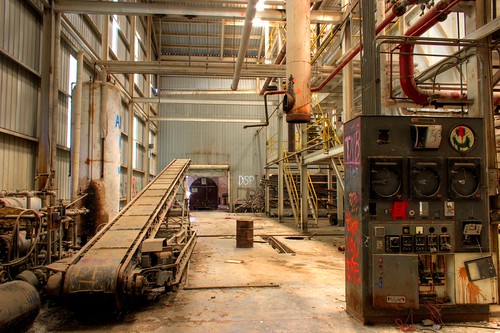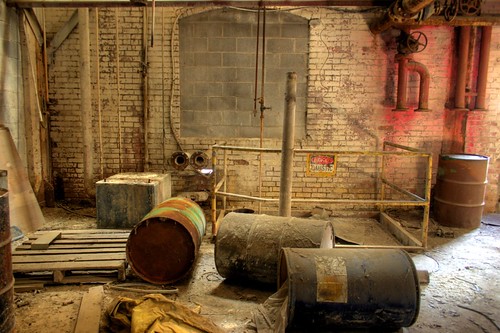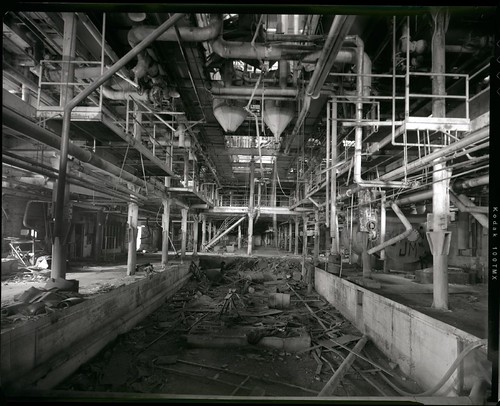Processing Sugar from Beets in the Early 1900s
By Jonathan H
This is the historic Longmont Refinery today. Captured from the ground floor, this large format image shows exactly how many pipes, catwalks, and tanks occupy a typical refinery. Walking through a sugar refinery fills your mind with conjecture, shock, amazement, and curiosity — all at once (photo copyright Jon Haeber)
Editor’s Note: From the founding of the Greeley Colony after the Homestead Act, rough and determined Coloradans were in a desperate search for the perfect cash crop. By 1900, their savior had come in the form of sugar beets. Before they transformed this sweet crop into a cornucopia of cash, however, they needed investment. In Part I, we saw how Colorado was the perfect geographical location for sugar beets. Now we’ll see why factories required massive up-front capital investment. In part III (coming soon), you’ll see how steam power transformed the typical sugar refinery; you’ll find out how corporate consolidation led Colorado agriculture into its days of glory; and you’ll find out why only two remaining refineries out of dozens are still active in Colorado.
 Inside these factories are massive machines — their own steel and brick monuments to a once-burgeoning industry. In order to understand the vastness of these factories, one must first understand the complicated process of sugar refining. For beets, this process multifarious and extremely energy-intensive. It required the importation of exorbitant amounts of coal and lime.
Inside these factories are massive machines — their own steel and brick monuments to a once-burgeoning industry. In order to understand the vastness of these factories, one must first understand the complicated process of sugar refining. For beets, this process multifarious and extremely energy-intensive. It required the importation of exorbitant amounts of coal and lime.

A map of the Longmont Sugar Refinery. Note the Steffens House (where MSG would later be made from beets), the incredibly large coal pits (this will be described more in Part III), and the extremely efficient train track layout.
Beet Washing and Flume Transport
First beets were both washed and transported through a series of flumes, but in order for them to be processed they needed to be brought to the top floor of the factory through a series of hoppers. Time was of the essence. As soon as the beets came in contact with water, they’d begin to diffuse their sugar.

Sugar beets needed to be carried to the top floor for the first step in processing. This required the use of an elaborate system of belts and flumes. Pictured above is an inclined conveyer that likely brought the beets up to a higher level. This conveyer is located at Eaton, Colorado (photo copyright Jon Haeber).
Cutting into Cossettes, Sublimation, and Lime Injection
Once on top, the beets went through a series of cutting machines, which sliced the beets into thin v-shaped pieces known as cossettes. The cossettes were fed into vast diffusion chambers, which were held under pressure, fed with boiling water, and allowed to steep for some time in order to sublimate the sugar from the cossettes. The spent cossettes were discarded, the steeped water was further brought into a soup of lime in order to purify the liquid-like sugar substance; then through a series of framed kelly filters; after which the filtered liquid was sent to a set of heat exchangers to keep it liquefied.

When one is in a sugar refinery, the sensory overload becomes overwhelming. These machines, like many in the refinery, perplexed me. However, I could reasonably deduce that — since they were on a lower story of the building, they were not the cutting (or cossette) cylinders. My educated guess says they are cylinders for griding lime rock. The pipe maze protruding from the cylinders probably sent the liquefied slurry of lime to be mixed with the sublimated sugar (photo copyright Jon Haeber).
Carbonation for Precipitation, Filtration, and Sulfur Station
Even after this process, the liquid, though containing no solids, remained a base due to the lime process. In order to solve this problem, the liquid was sent through carbonation tanks, where carbonic acid bubbled up through the juice, balancing the pH level and removing the lime. From there, it was sent to another set of filters, more heat exchangers, and on to the sulfur station.

These are the filter presses used to further purify the liquid sugar. In addition to filtering, the liquid had to go through both a lime and carbonation process before it became what is known as “standard liquor.”
It was at the sulfur station that the pH was further balanced and the sugar’s color was bleached white. Filtered one last time, it had finally became what the industry termed as “standard liquor,” containing a sugar content of 50-60%, but still in liquid form.

Workers stand in front of the famed lime kiln at the Eaton Refinery. Lime was an essential aspect of the refining process; it was useful in precipitating impurities in the beets.
Evaporation and Centrifuge Drying
In order to crystalize the liquid, the super-saturated liquid was sent through a series of evaporators, then to some centrifuges, and finally off to the market.

Drums of chemicals and grease are, not surprisingly, common in any sugar refinery. A typical refinery often leaves an indelible ecological footprint on the landscape (photo copyright Jon Haeber).
And that’s the simplified version! For the complete step-by-step process, visit this PDF document on Fort Collins sugar beet history.
Editor’s Addendum for Part II:As you see, a sugar factory was not only a multfarious process, it was also capital intensive. The Coloradans had a bounty, surely, but without the help of big money and intensive politicial lobbying, these factories would have never arisen from the Great Western Plains. In our third and final installment we’ll look at how the steam engine transformed the refineries in Colorado, along with corporate consolidation by Big Sugar headed by H.O. Havemeyer.


 Reddit!
Reddit! Del.icio.us
Del.icio.us Digg
Digg StumbleUpon
StumbleUpon Technorati
Technorati Blinklist
Blinklist Furl
Furl
Pingback: Bearings » Blog Archive » Steam Power in Colorado’s Sugar Factories